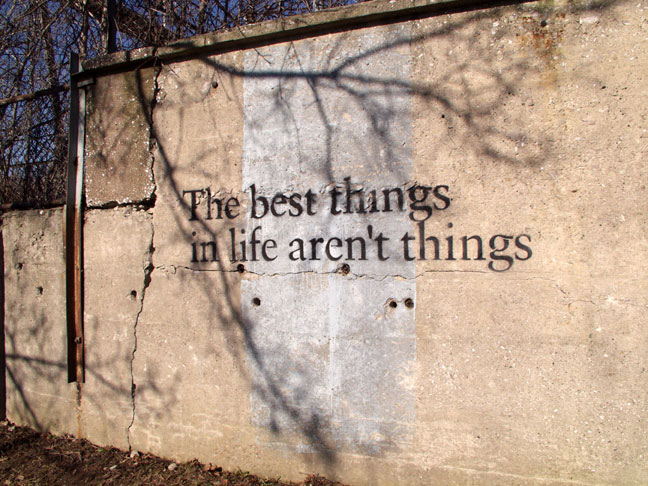Ah, November. Though remnants of Halloween are still underfoot (damn those plastic spiders—they get me every time), Christmas carols playing in the grocery store can mean just one thing: The holiday season has begun.
The holidays are a mixed bag—happiness-wise—even for the most Martha Stewart-y among us.
They are ripe for deep joy (more on that later), but rampant materialism and excessive busyness fuels stress, anxiety, and the perils of sleep deprivation.
November, though, contains the seeds of holiday happiness. The gratitude we cultivate with our children this month can neutralize some of the pitfalls of the holidays for our kids and ourselves.
First, the bad news: The holiday season brings with it boundless opportunities for unhappiness.
Cultural messages about the holidays are typically materialistic. Amped-up advertising tempts us and our children at every turn. (Yesterday, I found one of my daughters going through the recycling, pulling out catalogs I’d tried to get rid of. She couldn’t believe I’d dare recycle an American Girl catalog—the gall!).
Even the news is already covering holiday sales projections—which are taken, quite literally, as a marker of our collective well-being and health. These economic numbers aren’t trivial, but they’re definitely not the only important indicator of our well-being on which the media can report.
All this materialism doesn’t make us happy. Materialistic folks tend to be dissatisfied with their lives, have low self-esteem, be less integrated into their community, find less meaning in life, and be less concerned about the welfare of others. The list goes on and on: Materialistic people are also less satisfied with their family lives, the amount of fun and enjoyment they experience, and they are more likely to be depressed and envious.
Materialistic children don’t do as well in school and are at greater risk for depression, anxiety, and unhappiness; they are less inclined to connect to and help others in their neighborhood and community.
How can the holidays possibly be happy with all the prompts to think materialistic thoughts and the push to buy, buy, buy?
Now here’s the good news: Our collective American focus on gratitude this month can stave off the emotional dangers of the December holidays.
Here’s why: When we consciously practice feeling grateful and expressing our gratitude to others, our perception changes. We start to see the world and our lives differently. We don’t notice little grievances and daily hassles. Our brains simply can’t keep track of all the stimuli coming in, and our conscious focus on the positive simply doesn’t leave much room to ruminate on the negative. Gratitude changes what we see, hear, and feel—and what we don’t.
Ever have that experience where you notice something for the first time, and then afterward, you start seeing it everywhere? For example, after I looked up the definition of “itinerate,” I soon started seeing that word everywhere. I’ve since seen and heard it used so frequently that I can’t believe I didn’t know what it meant before.
A similar thing happens when we start trying to look for things to appreciate in life: They start popping up everywhere.
Teaching our children to focus on what they are grateful for can change their perception, too, making them at least partly immune to some of the materialistic messages that arrive with Santa.
Research suggests that this grateful perception can have a wide effect on our lives, well beyond Thanksgiving dinner. When we get into the habit of looking for things for which we feel grateful—and when we practice expressing gratitude to others—we become more grateful people year-round.
And grateful people tend to thrive. They get higher grades, are more satisfied with their lives, are more integrated socially (e.g. they feel like they are a significant part of their communities), and are more likely to experience “flow” in their activities. They show fewer signs of depression. Grateful teens also tend to feel less envy—something to remember the next time your kids get the “gimmies.”
Moreover, grateful kids are more motivated to help other people, perhaps because they feel more connected to others on a macro level. The researchers who conducted one study investigating this among middle school youth believe that gratitude can help “initiate upward spirals toward greater emotional and social well-being”—not just in our kids but in society.
Get your gratitude ball rolling by sharing your favorite gratitude practices! Leave a comment at the bottom of this post with your family’s favorite gratitude practice. Or, simply leave a comment with what you are grateful for. Why not start practicing gratitude now?
Your gratitude will inspire others.
@raisinghappines (Click to Tweet!)
Best known for her weekly Happiness Tips, Christine Carter, Ph.D., draws on psychology, sociology, and neuroscience, and uses her own real-world adventures to demonstrate happiness dos and don’ts in action. Dr. Carter is a sociologist at UC Berkeley’s Greater Good Science Center, and the author of RAISING HAPPINESS: 10 Simple Steps for More Joyful Kids and Happier Parents. She teaches happiness classes online throughout the year to a global audience on her website www.christinecarter.com.
*Image courtesy of lamazone .
*Selected references
Froh, Jeffrey J; Emmons, Robert A; Card, Noel A; Bono, Giacomo; Wilson, Jennifer A (April 2011). Gratitude and the Reduced Costs of Materialism in Adolescents. Journal of Happiness Studies, 12(2), 289- 302.
Froh, Jeffrey J; Bono, Giacomo, Emmons, Robert (June 2010). Being grateful is beyond good manners: Gratitude and motivation to contribute to society among early adolescents. Motivation and Emotion, 34(2), 144-157.












